The Characterization of Fatigue Damage of 316L Stainless Steel Parts Formed by Selective Laser Melting with Harmonic Generation Technique
Abstract
:1. Introduction
2. Generation of High-Order Harmonics
3. Experiment Procedure
3.1. Specimen Preparation
3.2. Experimental System and Measurement Method
4. Experimental Results
4.1. Nonlinearity Coefficients in the SLM 316L Stainless Steel Specimen
4.2. Fatigue Fracture Analysis
4.3. Fatigue Damage Mechanism of SLM 316L Stainless Steel Parts
5. Conclusions
- (1)
- In this study, a high-order harmonics detection method was used to explore the dependence of normalized ultrasonic nonlinear coefficients on the internal fatigue damage of SLM 316L stainless steel specimens. For this purpose, an effective testing system was established, and fatigue loading and nonlinear ultrasonic tests were carried out. TEM and SEM analyses were conducted.
- (2)
- The experiment results demonstrate that the normalized ultrasonic nonlinear coefficients β/β0 show a significant dependence on the number of fatigue cycles and that β/β0 obviously grows at a high rate once microcracks appear. The dependence of β/β0 on the number of fatigue cycles indicates the sensibility of this method, and β/β0 can effectively be used to characterize the fatigue damage degree in SLM 316L stainless steel parts caused by fatigue loading. The results of this experiment also show that the nonlinear ultrasonic effects appeared when the tested specimen was not subjected to fatigue loading. Transducers, power amplifier, and coupling problems existed in the experiment, which indicates that the inherent nonlinear effects should be considered in characterizing micro fatigue damage of SLM 316L stainless steel parts with β. The experimental results show that the normalized ultrasonic nonlinear coefficients are effective for characterizing the fatigue damage degree of SLM 316L stainless steel parts.
- (3)
- The normalized ultrasonic nonlinear coefficient is sensitive to the fatigue damage degree of SLM 316L stainless steel parts caused by fatigue loading. The relationship between the normalized ultrasonic nonlinear coefficients and the fatigue cycles was roughly in a mountain-shaped curve. The variation in the mountain-shaped curve can be divided into three stages. In the first stage, the multiplication of planar dislocation is the reason for the increase in the normalized ultrasonic nonlinear coefficients. In the second stage, with the accumulation of fatigue degree, the microcrack appears and gradually propagates, and the thicker dislocation vein gradually evolved into a more dense dislocation wall, so that the normalized ultrasonic nonlinear coefficients accelerate and reach the maximum value. In the third stage, due to the propagation of the microcrack into a macrocrack, the normalized ultrasonic nonlinear coefficients gradually decrease.
- (4)
- TEM and SEM analyses demonstrated that the variation in the mountain-shaped curve reflects the generation and evolution process of dislocation (such as planar dislocation, dislocation tangle, dislocation vein, dislocation wall, and dislocation cell) and cracks (microcracks, propagation of microcracks, and macrocracks) in the fatigue process of SLM 316L stainless steel parts, thereby revealing the fatigue damage mechanism of SLM 316L stainless steel parts.
Author Contributions
Funding
Institutional Review Board Statement
Informed Consent Statement
Data Availability Statement
Conflicts of Interest
References
- Kuznetsov, P.A.; Shakirov, I.V.; Bobyr’, V.V.; Zhukov, A.S.; Klimov, V.N. Features of Melt Gas Atomization and Selective Laser Melting of High-Strength Austenitic Nitrogen-Containing Steel Powders. Met. Sci. Heat Treat. 2020, 62, 76–80. [Google Scholar] [CrossRef]
- Le, K.; Wong, C.; Chua, K.; Tang, C.; Du, H. Discontinuity of overhanging melt track in selective laser melting process. Int. J. Heat Mass Transf. 2020, 162, 120284. [Google Scholar] [CrossRef]
- Ghorbani, J.; Li, J.; Srivastava, A.K. Application of optimized laser surface re-melting process on selective laser melted 316L stainless steel inclined parts. J. Manuf. Process. 2020, 56, 726–734. [Google Scholar] [CrossRef]
- Park, H.S.; Nguyen, D.-S. Study on Flaking Behavior in Selective Laser Melting Process. Procedia CIRP 2017, 63, 569–572. [Google Scholar] [CrossRef]
- Peng, T.; Chen, C. Influence of energy density on energy demand and porosity of 316L stainless steel fabricated by selective laser melting. Int. J. Precis. Eng. Manuf. Green Technol. 2018, 5, 55–62. [Google Scholar] [CrossRef]
- Qiu, C.L.; Kindi, M.A.; Aladawi, A.S.; Hatmi, I.A. A comprehensive study on microstructure and tensile behavior of a selectively laser melted stainless steel. Sci. Rep. 2018, 8, 7785. [Google Scholar] [CrossRef]
- Liu, B.; Zhao, Z.Y.; Bai, P.K.; Liang, M.J.; Guan, R.G. The Compressive Behavior of a Porous 316L Stainless Steel Prepared by Selective Laser Melting. Lasers Eng. 2019, 42, 381–390. [Google Scholar]
- Plessis, A.D.; Roux, S.G.; Guelpa, A. Comparison of medical and industrial X-ray computed tomography for non-destructive testing. Case Stud. Nondestruct. Test. Eval. 2016, 6, 17–25. [Google Scholar] [CrossRef] [Green Version]
- Kolkoori, S.; Wrobel, N.; Zscherpel, U.; Ewert, U. A new X-ray backscatter imaging technique for non-destructive testing of aerospace materials. NDT E Int. 2015, 70, 41–52. [Google Scholar] [CrossRef]
- Yan, X.-L.; Dong, S.-Y.; Xu, B.-S.; Cao, Y. Progress and Challenges of Ultrasonic Testing for Stress in Remanufacturing Laser Cladding Coating. Materials 2018, 11, 293. [Google Scholar] [CrossRef] [PubMed] [Green Version]
- Jasiūnienė, E.; Mažeika, L.; Samaitis, V.; Cicėnas, V.; Mattsson, D. Ultrasonic non-destructive testing of complex titanium/carbon fibre composite joints. Ultrasonics 2019, 95, 13–21. [Google Scholar] [CrossRef] [PubMed]
- Yan, X.; Xu, X. Method for accurately measuring of acoustic time difference based on optimal threshold. Measurement 2021, 171, 108769. [Google Scholar] [CrossRef]
- Janousek, L.; Stubendekova, A.; Smetana, M. Novel insight into swept frequency eddy-current non-destructive evaluation of material defects. Measurement 2018, 116, 246–250. [Google Scholar] [CrossRef]
- Rusli, N.S.; Abidin, I.Z.; Aziz, S.A. A review on eddy current thermography technique for non-destructive testing application. J. Teknol. 2016, 78, 127–132. [Google Scholar] [CrossRef] [Green Version]
- Wang, X.; Wang, H.; Liang, R.Y.; Liu, Y. A semi-supervised clustering-based approach for stratification identification using borehole and cone penetration test data. Eng. Geol. 2019, 248, 102–116. [Google Scholar] [CrossRef]
- Shelikhov, G.S.; Glazkov, Y.A. On the improvement of examination questions during the nondestructive testing of magnetic powder. Russ. J. Nondestruct. Test. 2011, 47, 112–117. [Google Scholar] [CrossRef]
- Kim, Y.; Lim, H.J.; Sohn, H. Nonlinear ultrasonic modulation based failure warning for aluminum plates subject to fatigue loading. Int. J. Fatigue 2018, 114, 130–137. [Google Scholar] [CrossRef]
- Zhou, Z.G.; Liu, S.M. Nonlinear ultrasonic techniques used in nondestructive testing: A review. J. Mech. Eng. 2011, 47, 2–11. [Google Scholar] [CrossRef]
- Gebrekidan, S.; Kang, T.; Kim, H.-J.; Song, S.-J. Nonlinear ultrasonic characterization of early degradation of fatigued Al6061-T6 with harmonic generation technique. Ultrasonics 2018, 85, 23–30. [Google Scholar] [CrossRef]
- Jhang, K.-Y.; Kim, K.-C. Evaluation of material degradation using nonlinear acoustic effect. Ultrasonics 1999, 37, 39–44. [Google Scholar] [CrossRef]
- Thanseer, P.M.; Metya, A.K.; Sagar, S.P. Development of a Non-collinear Nonlinear Ultrasonic-Based Technique for the Assessment of Crack Tip Deformation. J. Mater. Eng. Perform. 2017, 26, 2632–2639. [Google Scholar] [CrossRef]
- Vetrone, J.; Obregon, J.E.; Indacochea, E.J.; Ozevin, D. The characterization of deformation stage of metals using acoustic emission combined with nonlinear ultrasonics. Measurement 2021, 178, 109407. [Google Scholar] [CrossRef]
- Liu, P.; Jang, J.; Yang, S.; Sohn, H. Fatigue crack detection using dual laser induced nonlinear ultrasonic modulation. Opt. Lasers Eng. 2018, 110, 420–430. [Google Scholar] [CrossRef]
- Ha, H.; Kim, J.; Jhang, K.-Y. Influence of Surface Roughness on Measurement of the Ultrasonic Nonlinear Parameter. J. Korean Soc. Nondestruct. Test. 2017, 37, 223–229. [Google Scholar] [CrossRef]
- Choi, S.; Ryu, J.; Kim, J.-S.; Jhang, K.-Y. Comparison of Linear and Nonlinear Ultrasonic Parameters in Characterizing Grain Size and Mechanical Properties of 304L Stainless Steel. Metals 2019, 9, 1279. [Google Scholar] [CrossRef] [Green Version]
- Jiao, J.; Sun, J.; Li, N.; Song, G.; Wu, B.; He, C. Micro-crack detection using a collinear wave mixing technique. NDT E Int. 2013, 62, 122–129. [Google Scholar] [CrossRef]
- Liu, P.P.; Jang, J.H.; Sohn, H. Crack localization by laser-induced narrowband ultrasound and nonlinear ultrasonic modulation. Smart Struct. Syst. 2020, 25, 301–310. [Google Scholar]
- Jang, J.; Liu, P.; Kim, B.; Kim, S.-W.; Sohn, H. Silicon wafer crack detection using nonlinear ultrasonic modulation induced by high repetition rate pulse laser. Opt. Lasers Eng. 2020, 129, 106074. [Google Scholar] [CrossRef]
- Yang, J.; Luo, L.; Yang, K.; Zhang, Y. Ultrasonic Phased Array Sparse TFM Imaging Based on Virtual Source and Phase Coherent Weighting. IEEE Access 2020, 8, 185609–185618. [Google Scholar] [CrossRef]
- Cantrell, J.H. Quantitative assessment of fatigue damage accumulation in wavy slip metals from acoustic harmonic generation. Philos. Mag. 2006, 86, 1539–1554. [Google Scholar] [CrossRef] [Green Version]
- Yan, X.L.; Xu, X.S.; Pan, Q.X. Study on the measurement of stress in the surface of selective laser melting forming parts based on the critical refraction longitudinal wave. Coatings 2019, 10, 5. [Google Scholar] [CrossRef] [Green Version]
- Bae, J.H.; Yu, J.M.; Dao, V.H.; Lok, V.; Yoon, K.B. Effects of processing parameters on creep behavior of 316L stainless steel produced using selective laser melting. J. Mech. Sci. Technol. 2021, 35, 3803–3812. [Google Scholar] [CrossRef]
- Kong, D.; Ni, X.; Dong, C.; Lei, X.; Zhang, L.; Man, C.; Yao, J.; Cheng, X.; Li, X. Bio-functional and anti-corrosive 3D printing 316L stainless steel fabricated by selective laser melting. Mater. Des. 2018, 152, 88–101. [Google Scholar] [CrossRef]
- Hajnys, J.; Pagáč, M.; Měsíček, J.; Petru, J.; Król, M. Influence of Scanning Strategy Parameters on Residual Stress in the SLM Process According to the Bridge Curvature Method for AISI 316L Stainless Steel. Materials 2020, 13, 1659. [Google Scholar] [CrossRef] [PubMed] [Green Version]
- Hikata, A.; Elbaum, C. Generation of Ultrasonic Second and Third Harmonics Due to Dislocations. I. Phys. Rev. 1966, 144, 469. [Google Scholar] [CrossRef]
- Bachurin, D.V.; Murzaev, R.T.; Nazarov, A.A. Ultrasonic influence on evolution of disordered dislocation structures. Model. Simul. Mater. Sci. Eng. 2017, 25, 085010. [Google Scholar] [CrossRef]
- Masurkar, F.; Tse, P.; Yelve, N. Evaluation of inherent and dislocation induced material nonlinearity in metallic plates using Lamb waves. Appl. Acoust. 2018, 136, 76–85. [Google Scholar] [CrossRef]
- Zhu, W.; Deng, M.; Xiang, Y.; Xuan, F.-Z.; Liu, C.; Wang, Y.-N. Modeling of ultrasonic nonlinearities for dislocation evolution in plastically deformed materials: Simulation and experimental validation. Ultrasonics 2016, 68, 134–141. [Google Scholar] [CrossRef] [PubMed]
- Nazarove, V.E.; Sutin, A.M. Nonlinear elastic constants of solids with cracks. J. Acoust. Soc. Am. 1997, 102, 3349–3354. [Google Scholar] [CrossRef]
- Biwa, S.; Hiraiwa, S.; Matsumoto, E. Experimental and theoretical study of harmonic generation at contacting interface. Ultrasonics 2006, 44, e1319–e1322. [Google Scholar] [CrossRef] [PubMed]
- Alston, J.; Croxford, A.; Potter, J.; Blanloeuil, P. Nonlinear non-collinear ultrasonic detection and characterisation of kissing bonds. NDT E Int. 2018, 99, 105–116. [Google Scholar] [CrossRef]
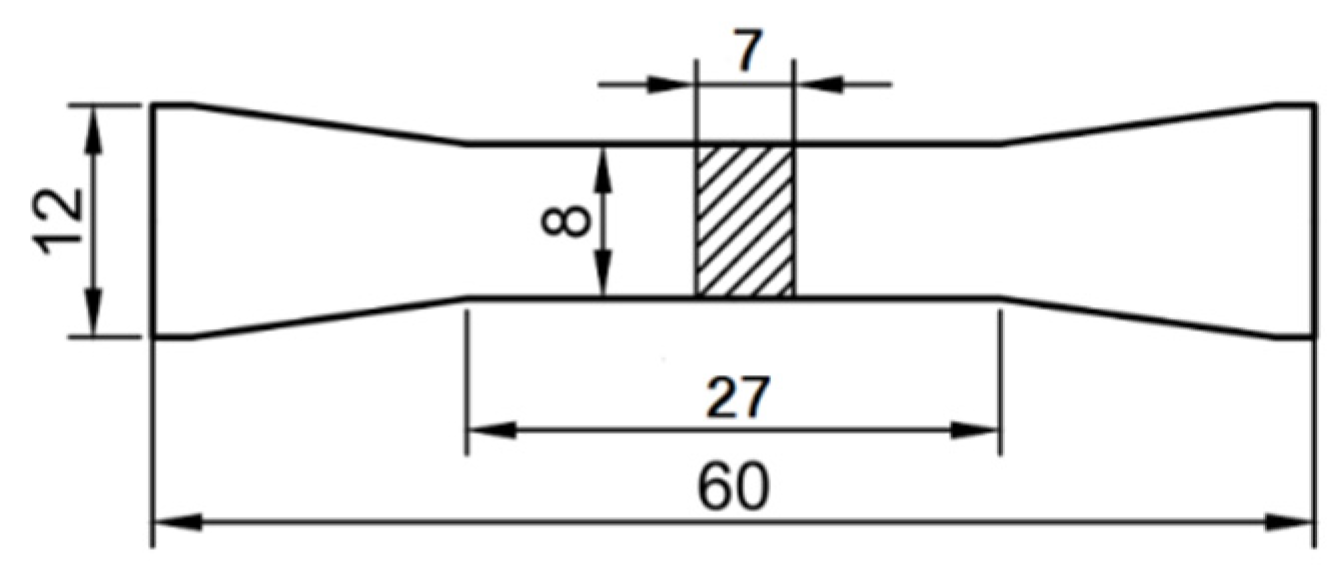

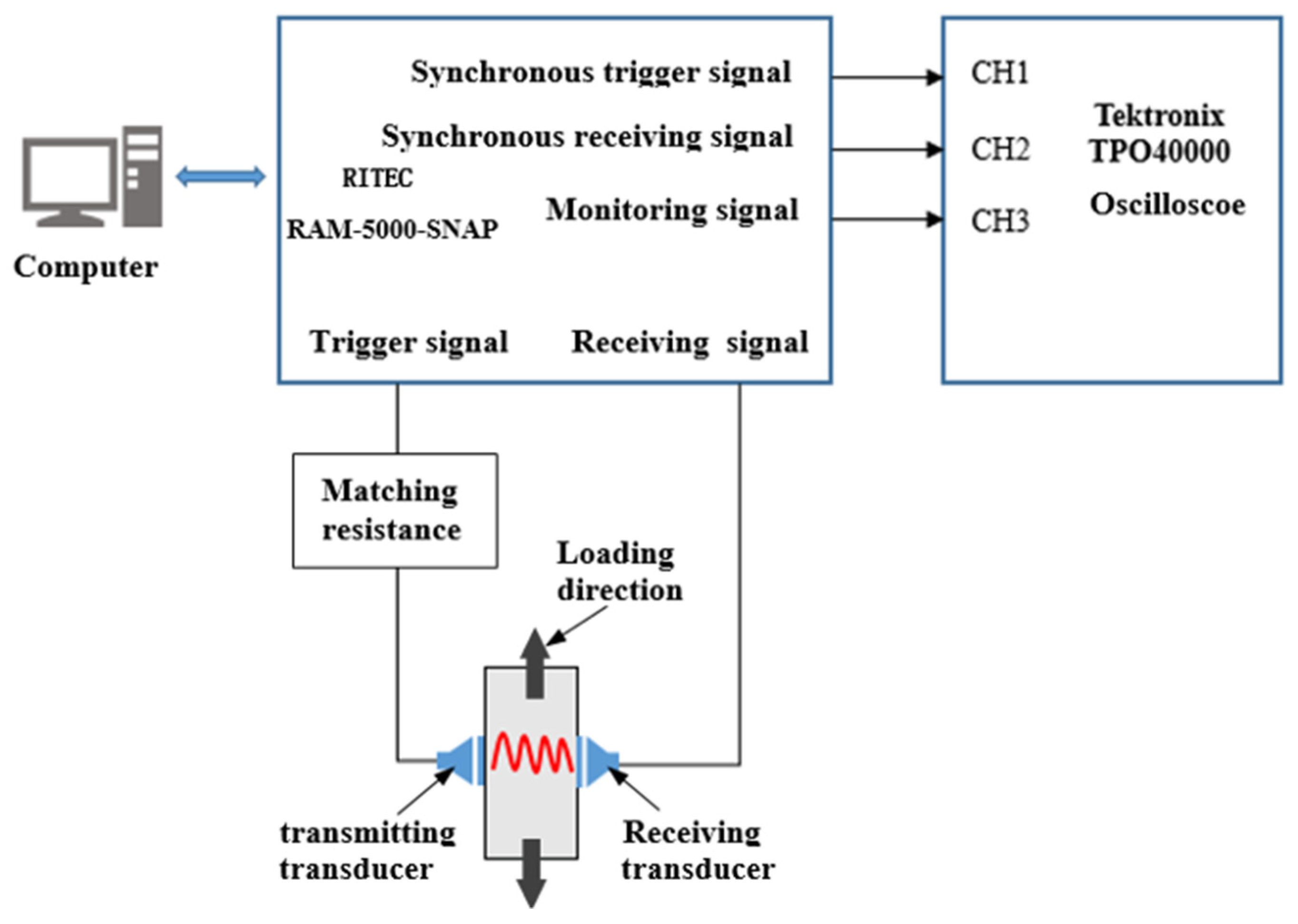

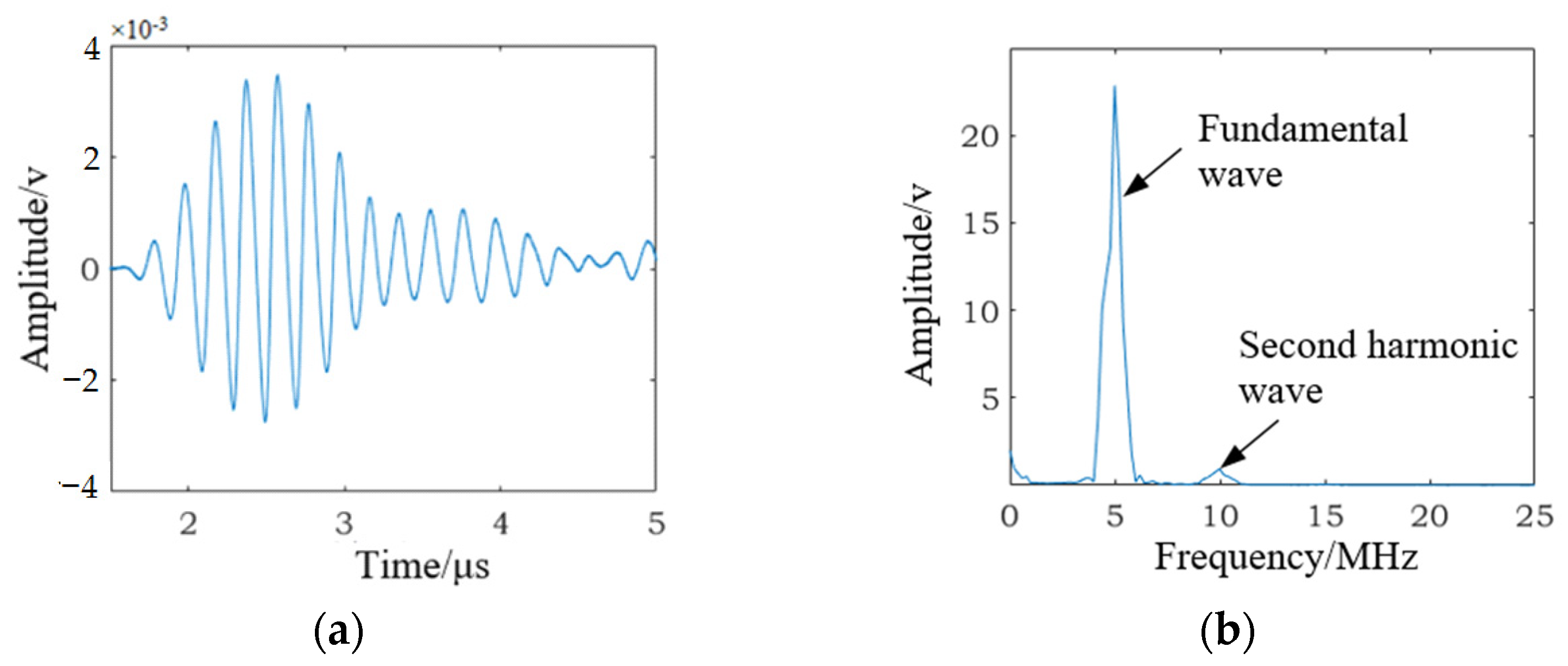
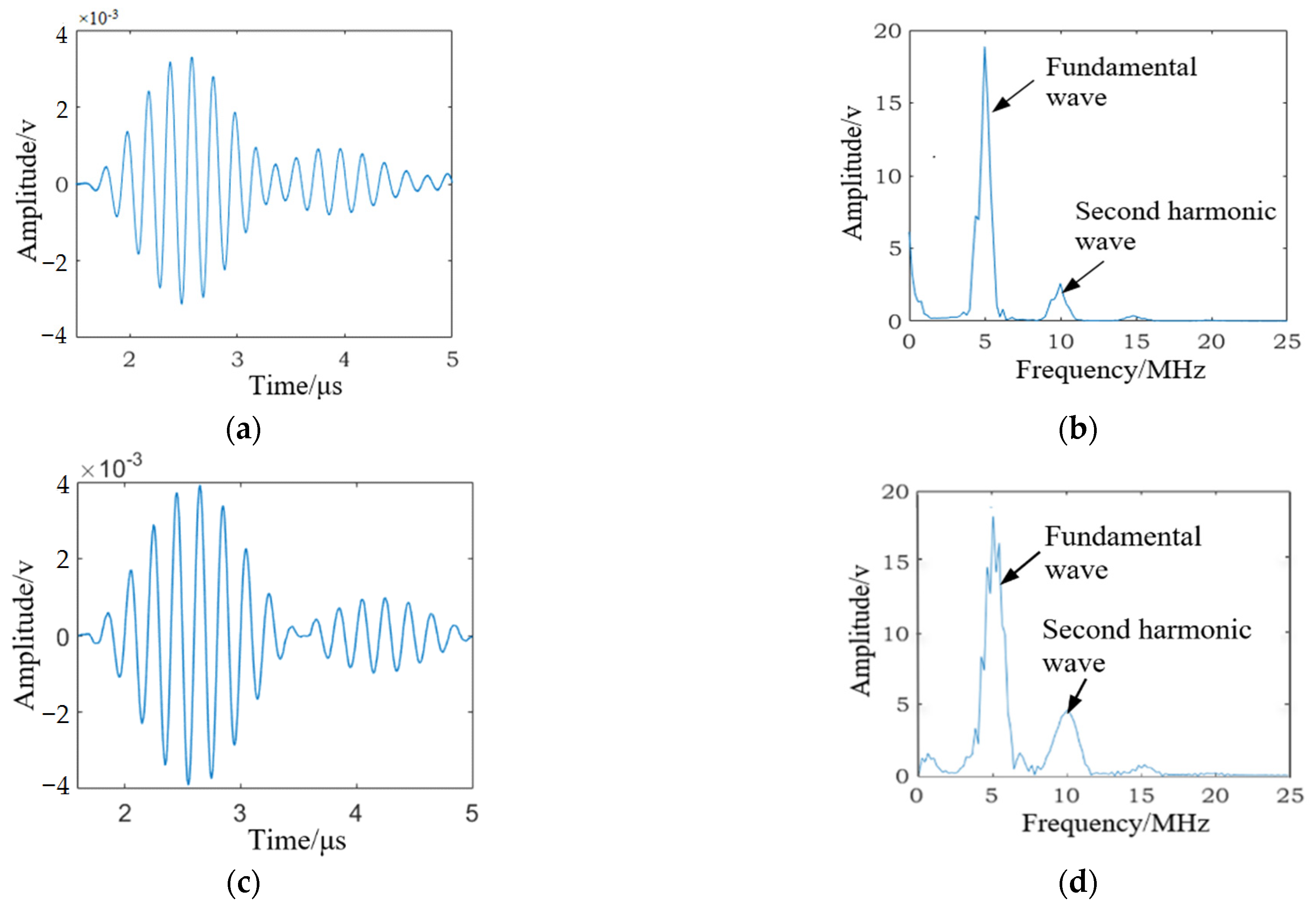


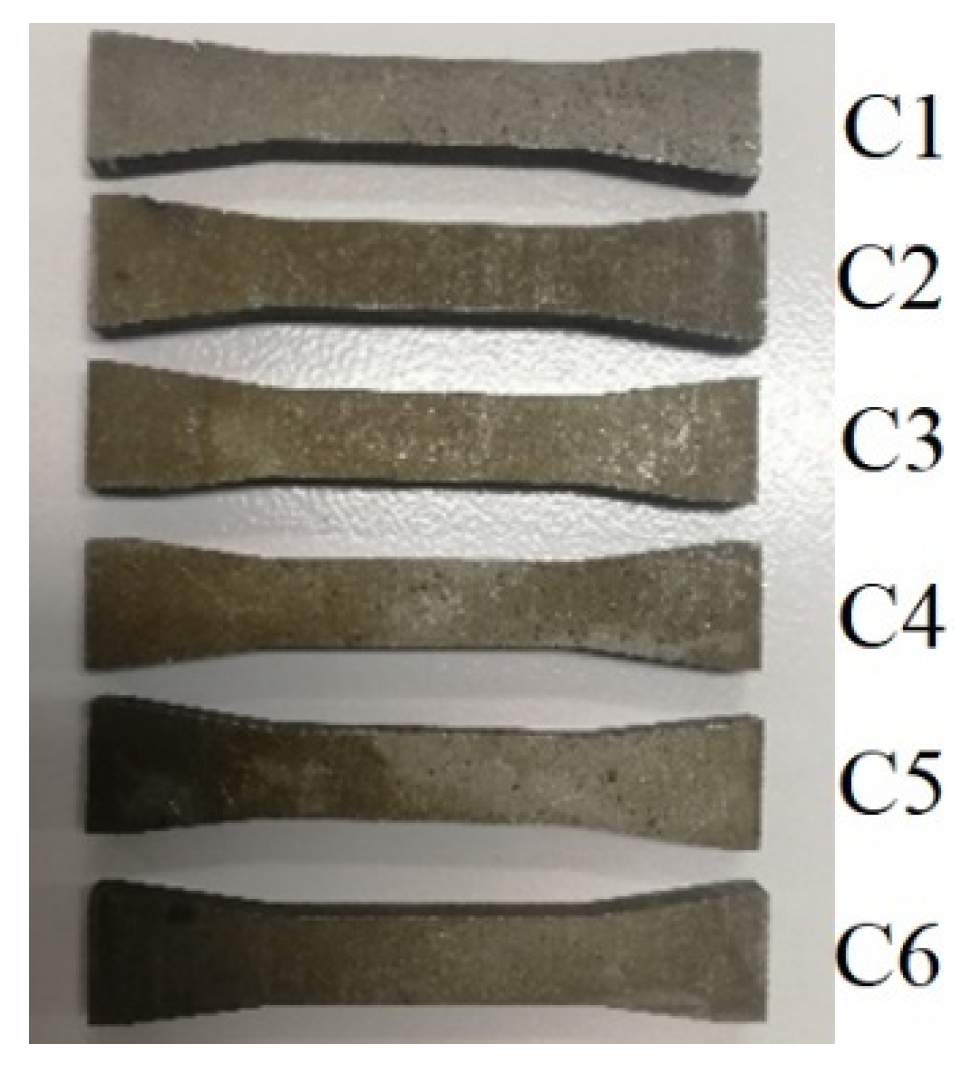
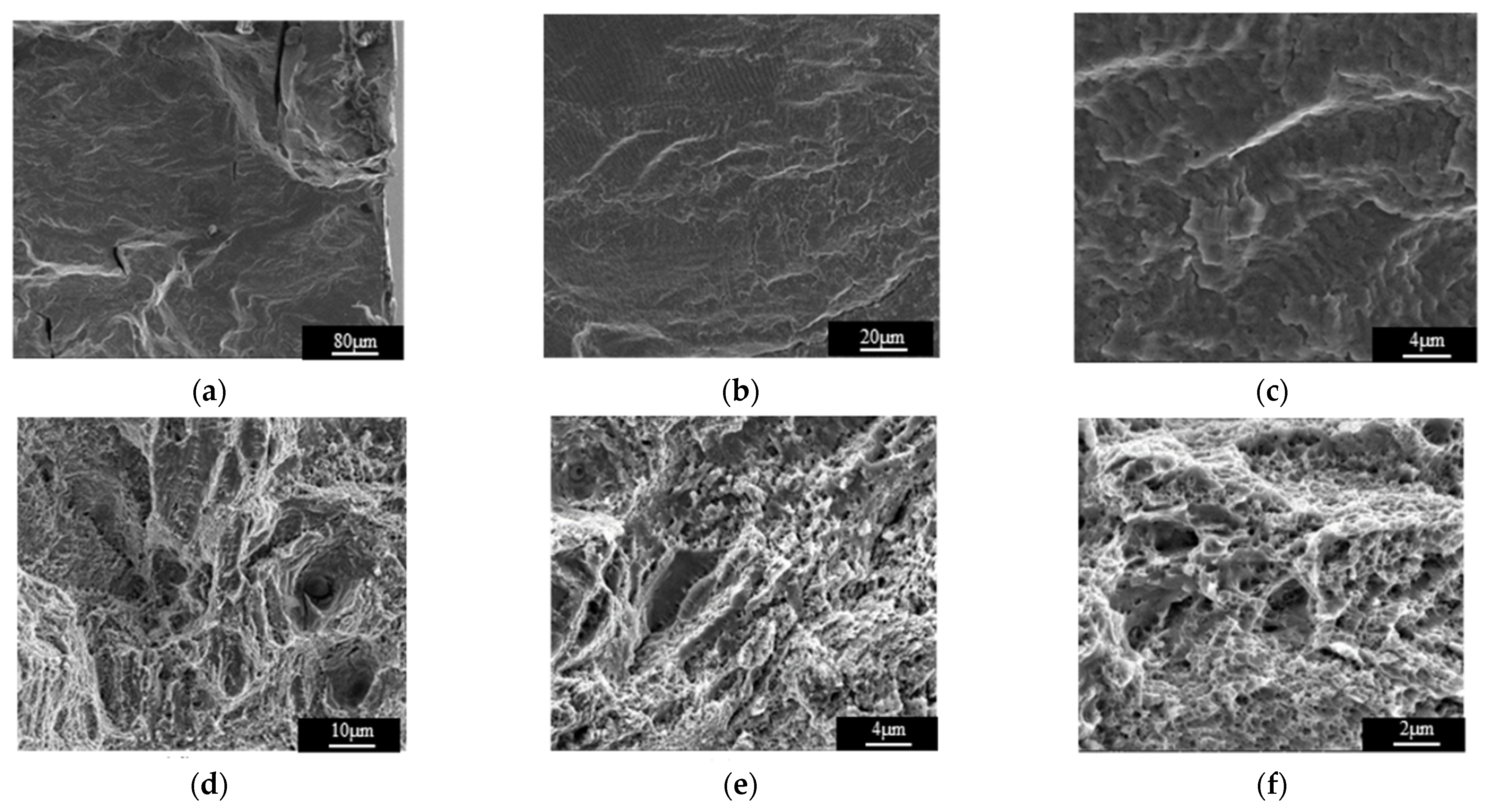
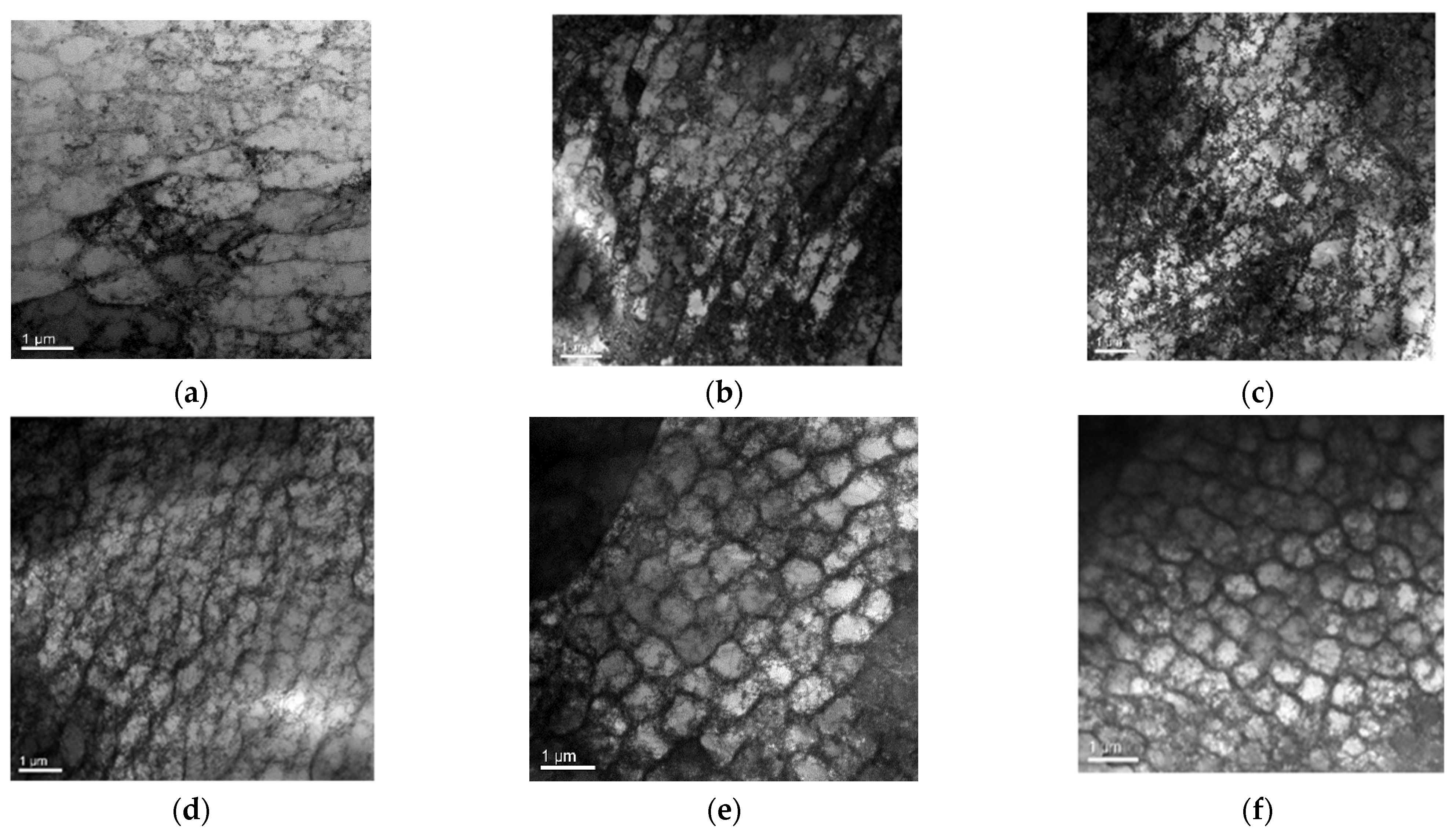
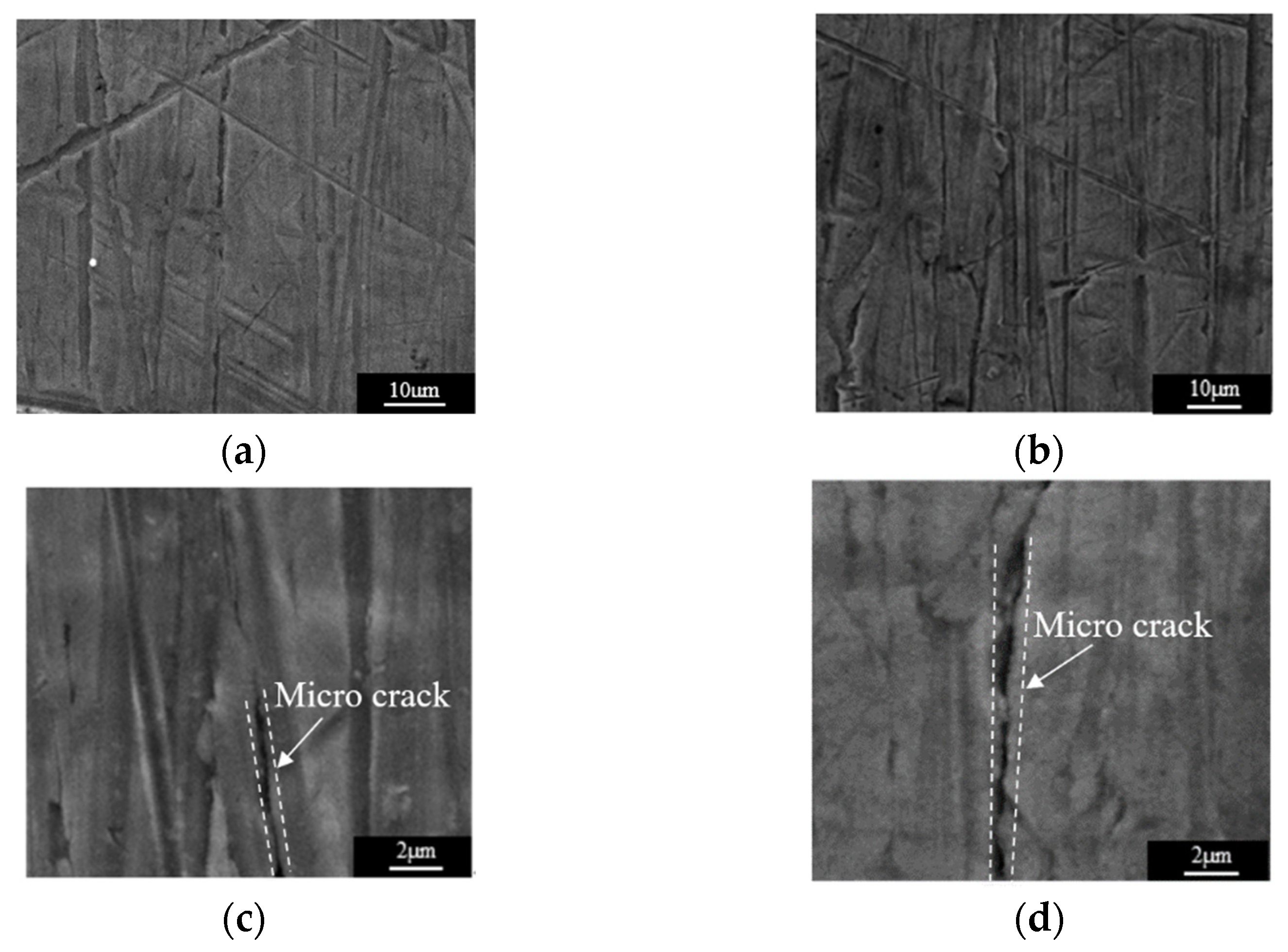
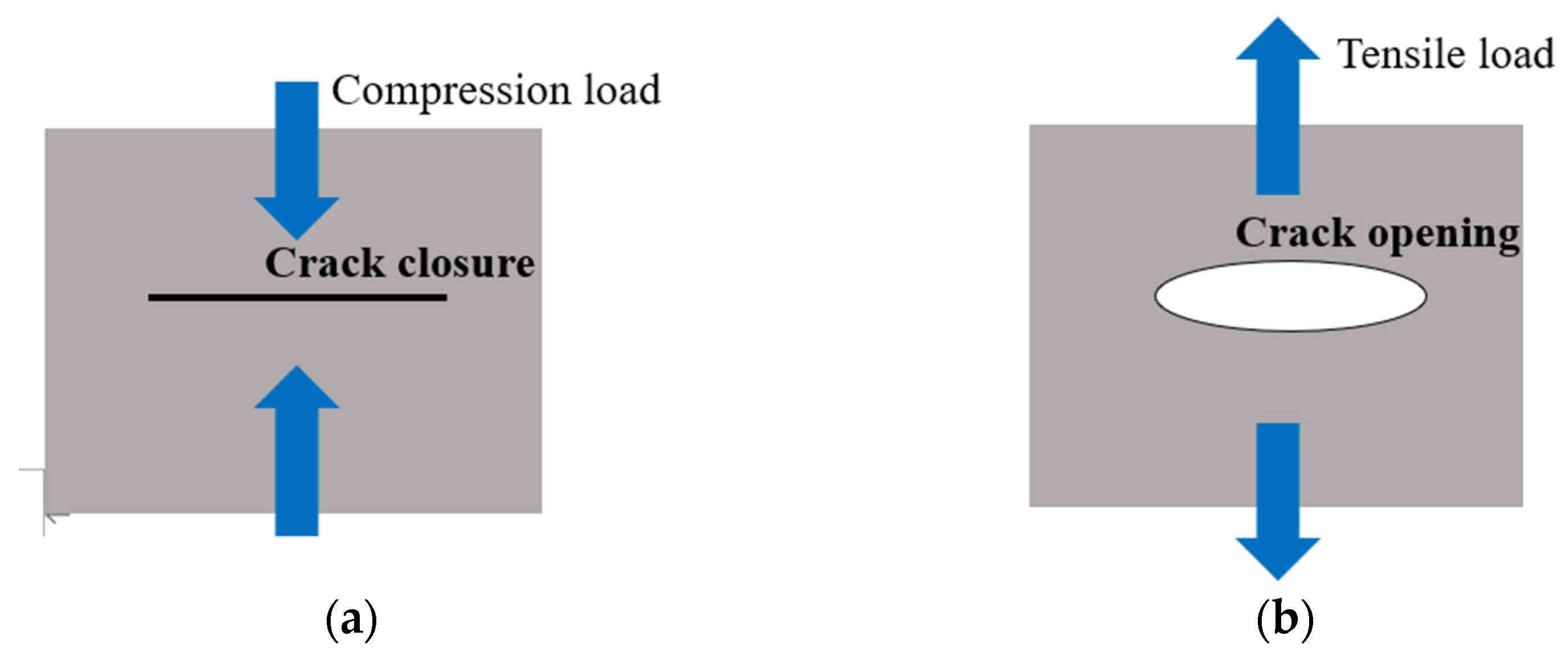

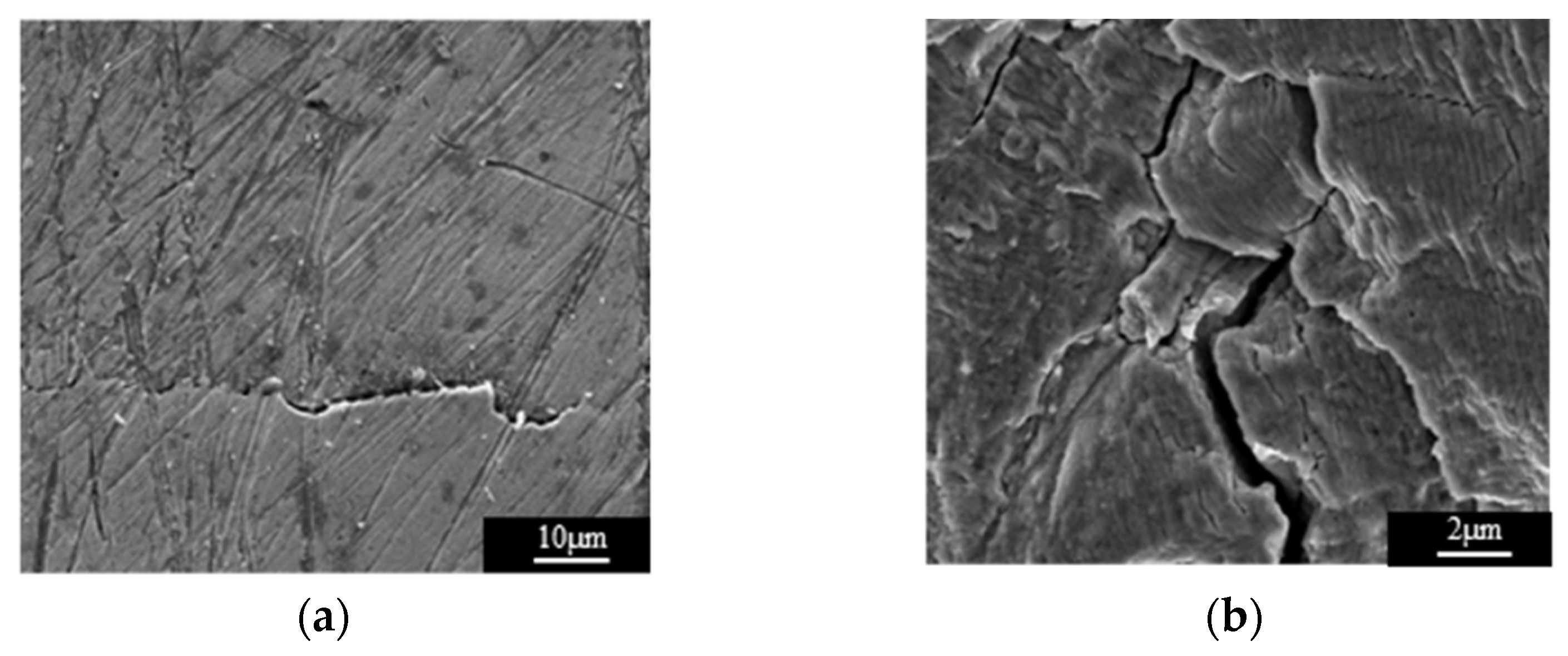
| Element | C | Cr | Ni | Mo | Si | Mn | O | P | Fe |
|---|---|---|---|---|---|---|---|---|---|
| Content | 0.03 | 17.5 | 12.06 | 2.06 | 0.86 | 0.3 | 0.1 | 0.04 | Bal. |
| Laser Power (W) | Scanning Speed (mm/s) | Layer Thickness (μm) | Scanning Interval (mm) | Spot Diameter (μm) | Volume Fraction of Oxygen (%) |
|---|---|---|---|---|---|
| 250 | 750 | 30 | 0.065 | 80 | 0.03 |
| Specimen Number | C1 | C2 | C3 | C4 | C5 | C6 |
|---|---|---|---|---|---|---|
| Fatigue cycles (ten thousand times) | 1 | 2 | 3 | 4 | 5 | 6.892 |
| Maximum stress (MPa) | 400 | 400 | 400 | 400 | 400 | 400 |
| Stress ratio r | 0.1 | 0.1 | 0.1 | 0.1 | 0.1 | 0.1 |
| Loading frequency (Hz) | 10 | 10 | 10 | 10 | 10 | 10 |
Publisher’s Note: MDPI stays neutral with regard to jurisdictional claims in published maps and institutional affiliations. |
© 2022 by the authors. Licensee MDPI, Basel, Switzerland. This article is an open access article distributed under the terms and conditions of the Creative Commons Attribution (CC BY) license (https://creativecommons.org/licenses/by/4.0/).
Share and Cite
Qiao, R.; Yan, X. The Characterization of Fatigue Damage of 316L Stainless Steel Parts Formed by Selective Laser Melting with Harmonic Generation Technique. Materials 2022, 15, 718. https://doi.org/10.3390/ma15030718
Qiao R, Yan X. The Characterization of Fatigue Damage of 316L Stainless Steel Parts Formed by Selective Laser Melting with Harmonic Generation Technique. Materials. 2022; 15(3):718. https://doi.org/10.3390/ma15030718
Chicago/Turabian StyleQiao, Rui, and Xiaoling Yan. 2022. "The Characterization of Fatigue Damage of 316L Stainless Steel Parts Formed by Selective Laser Melting with Harmonic Generation Technique" Materials 15, no. 3: 718. https://doi.org/10.3390/ma15030718
APA StyleQiao, R., & Yan, X. (2022). The Characterization of Fatigue Damage of 316L Stainless Steel Parts Formed by Selective Laser Melting with Harmonic Generation Technique. Materials, 15(3), 718. https://doi.org/10.3390/ma15030718






